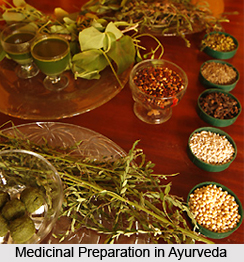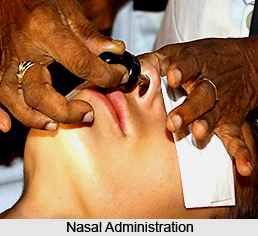 Panchakarma is Ayurveda’s primary purification and detoxification treatment. Panchakarma literally signifies the "Five Therapies". It is an all-inclusive system of knowledge and practices to remove toxins from the body and restore the body’s harmony with nature. These five curative means of eliminating toxins from the body are;
Panchakarma is Ayurveda’s primary purification and detoxification treatment. Panchakarma literally signifies the "Five Therapies". It is an all-inclusive system of knowledge and practices to remove toxins from the body and restore the body’s harmony with nature. These five curative means of eliminating toxins from the body are;Vamana or Emesis Therapy: When there is blockage in the lungs leading to recurrent attacks of bronchitis, colds, cough or asthma, the Ayurvedic treatment is therapeutic vomiting or Vamana, to eliminate the kapha that is responsible for the deposition of the excess mucus within the body.
Virechana or Purgation Therapy: When excess of bile or pitta is secreted, it often gets accumulated in the gall bladder, liver and small intestine. This in turns results in rashes, spots, skin inflammation, persistent attacks of fever, vomiting, feeling of nausea and jaundice. In such cases, therapeutic purgation or virechana helps to normalise the bodily activities.
Basti or Enema Therapy: Ayurvedic basti involves the introduction of herbal preparations of sesame oil and the like into the rectum. It relieves chronic fever, constipation, cold, sexual disorders, heart pain, kidney stones, backache, sciatica and other pains in the joints. Many other vata disorders such as rheumatism, arthritis, gout, muscle spasms and headaches may also be cured through basti.
Nasya or Nasal Administration: The administration of medication through the nasal passage is called Nasya. A surplus of bodily humours accumulated in the sinus, throat, nose or head areas is eliminated by means of Nasya.

Raktamokshana: Toxins present in the gastro-intestinal tract get mixed with blood and are circulated throughout the body. The body suffers from various skin disorders. In such cases, the purification of blood or raktamoksha becomes necessary along with internal medication. Raktamoksha is also followed in case of ailments like enlarged liver, spleen and gout.
They facilitate the removal of toxins that cause anxiety and illness, and also restore the proper balance of the three doshas. If it is done properly, appropriate healing along with lucid intelligence, sharpness of the senses, stability of the body, normalized capability of digestion and absorption, prolongation of youth are all achieved. Panchakarma is in fact only a part of a group of remedial measures belonging to a set of purification procedures called ‘Shodhana’.
For more, visit the link below: